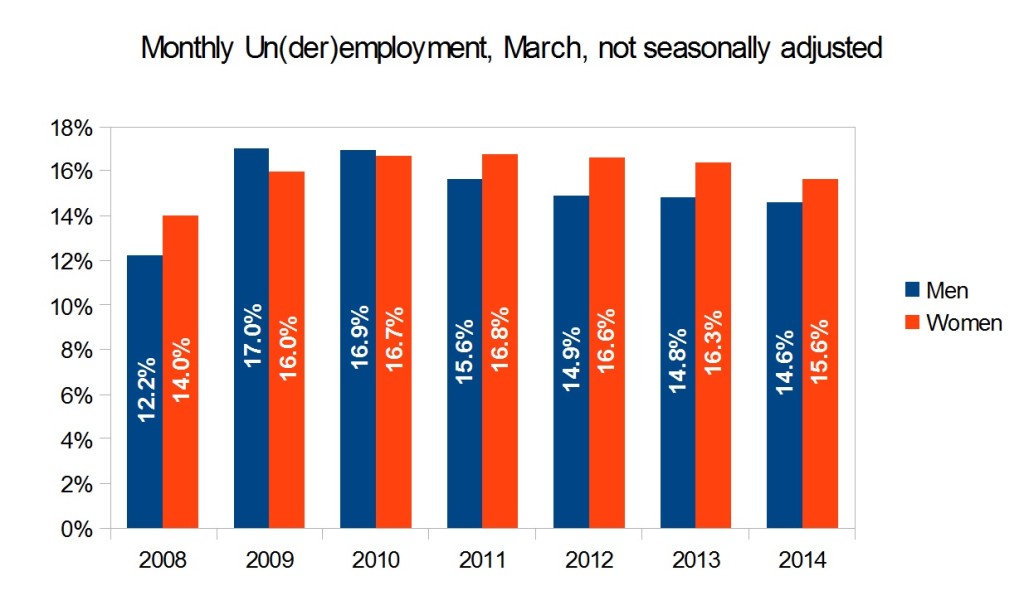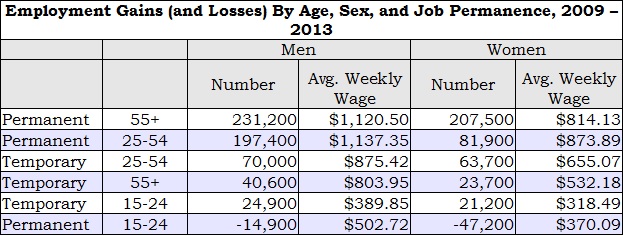He-cession to She-precarious recovery?
As Armine has pointed out recently, women play a key role in economic recoveries: (She says it so well, I have to quote her directly:)
Every recession is a “he-cessionâ€: men lose more jobs than women in a downturn because the first thing to slow is the production in goods-producing industries that are typically male-dominated (mining, forestry, construction, manufacturing). Every early stage of recovery is a “she-coveryâ€: men who lose $30 an hour jobs wince at accepting $15 an hour offers, but women grab them to make sure the bills get paid.
This shows up in the underemployment rate, which captures the large number of women who work part-time jobs while they’re still looking for full-time work.
Let’s compare seasonally unadjusted underemployment rates for men and women over the past seven March(s). In the midst of the recession (March 2009), men’s underemployment rate was higher than women’s. While men’s underemployment rate fell between 2009 and 2011, women’s actually rose, and peaked in 2011.
This evidence supports the need for public sector investment / stimulus spending that is outside traditional physical infrastructure. A two pronged approach is required, where we both encourage young women to enter the skilled trades and invest in social infrastructure such as early childcare and education.
Pay equity legislation and living wages are key as well. Because while it’s admirable that women are willing to work low wage part-time jobs to make sure their family has enough to eat, this ends up depressing wages in female dominated sectors such as retail and food services. This contributes to increasing inequality.
On this, #EqualPayDay2014, I’d just like to point out the gross unfairness of women’s wages already. Go ahead and tell me that women work fewer (paid) hours, or in different occupations, I will tell you that is part of the systemic problem keeping women’s wages low.
Note in the above graph that women in each age / job permanence category gained fewer jobs (or lost more) between 2009 and 2013. Also note, that in each category women’s weekly wages are depressingly far behind their male counterparts.
And always, this data comes with the caveat that the situation is far worse for racialized women, women new to Canada, or women living with disabilities.
Something’s gotta give.



If the author could post the origin of these figures and stats it would be very useful thanks
Sorry, I forgot the sources! I calculate the underemployment rate (the first graph) as described here: http://www.progressive-economics.ca/2014/03/21/how-to-calculate-underemployment/
The data in the table is from CANSIM table 282-0074, where I calculate the net new jobs between 2009 and 2013.
As I posted on my website- I am not so sure that this was a he-cession- I calculated that women may have lost far more than men in terms of jobs over the length of the recession- up to 400,000. This of course includes potential jobs- if one looks at the increase in employment rates and that which was lost- which is very similar to the methodology many progressive economists on here used to evaluate the jobs lost in the recession- it all has to do with rates, and change- not merely the levels. However it does seem to be the case that women in precarious jobs are indeed leading the way way in this stagnating wages and slow job growth. This again is explained by a resumption in the rates of change we have seen historically in employment growth when looking by gender.
See my article hear.
http://www.livingwork.ca/?p=75
“A two pronged approach is required, where we both encourage young women to enter the skilled trades and invest in social infrastructure such as early childcare and education.”
Also consider the Job Guarantee Program.
This letter was published in the National Post April 5 (without the footnote).
Re: It’s the interns who lose in crackdown on unpaid internships, Andrew Coyne, April 2, 2014
In the 1970s, the Local Initiatives Program created jobs and community benefits which were funded by the federal government and delivered through local non-profit organizations and citizen groups. Projects covered such areas as arts and culture, recreation, tourism, research and the environment. If reintroduced today, internships could be part of this initiative.
Society benefits because young people need work experience while those who have lost jobs must find new ones before skills are lost. Long-term unemployment can also lead to pathologies such as sickness, substance abuse, and mental health issues.
In addition, a job guarantee program (JG) with a minimum livable wage would provide the economy with counter-cyclical stability. When times are bad, JG hiring would pick up. But when times improve, the private sector would bid employees out of the program.
British economist John Maynard Keynes maintained that no law of nature requires us to keep large swaths of our workforce unemployed and that those who believe otherwise have minds “fuddled with nonsense”.
Larry Kazdan
Footnote:
The Job Guarantee: A Government Plan for Full Employment
http://www.thenation.com/article/161249/job-guarantee-government-plan-full-employment
The benefits of full employment include production of goods, services and income; on-the-job training and skill development; poverty alleviation; community building and social networking; social, political and economic stability; and social multipliers (positive feedbacks and reinforcing dynamics that create a virtuous cycle of socioeconomic benefits). An “employer of last resort†program would restore the government’s lost commitment to full employment in recognition of the fact that the total impact would exceed the sum of the benefits.